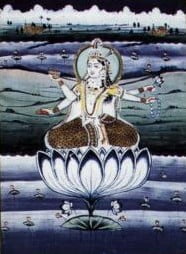Lalita Sahasranama: Healing through Devotion
Lalita Sahasranama is a hymn dedicated to the Hindu goddess Lalita, also known as Tripura Sundari. It is believed to be a powerful tool for invoking the blessings of the goddess and for healing physical and emotional ailments. The hymn comprises one thousand names or epithets of the goddess, each representing a different aspect of her divine nature.
Devotees of Lalita Sahasranama believe that chanting or reciting the hymn with devotion can bring about a profound transformation in one’s life. This article explores the significance of Lalita Sahasranama in the context of healing and the ways in which devotion to the goddess can facilitate this process.
Harnessing the Power of Devotion for Healing
According to the Hindu tradition, devotion or bhakti is a powerful means of connecting with the divine, and of transcending the limitations of the ego. In the context of healing, devotion can be seen as a way of surrendering one’s sense of control or attachment to the outcome, and of accepting the present moment with gratitude and humility.
When we chant or recite Lalita Sahasranama with devotion, we are not only invoking the blessings of the goddess but also opening ourselves up to her divine energy. This energy can help us to release negative emotions, such as fear, anger, and grief, that may be blocking our healing process. It can also help us to cultivate positive qualities, such as faith, compassion, and surrender, that are essential for healing and spiritual growth.
Moreover, Lalita Sahasranama is said to contain hidden meanings and symbols that can be interpreted in different ways depending on one’s level of understanding. For instance, the names of the goddess can be seen as representing the chakras or energy centers of the body, and chanting them can help to balance and activate these centers. Similarly, the hymn can be seen as a map of the spiritual journey, with each name representing a milestone or a stage of realization.
Another aspect of Lalita Sahasranama that is relevant to healing is its connection with the divine feminine. The goddess Lalita is often depicted as a beautiful and compassionate mother who nurtures and protects her devotees. By invoking her through the hymn, we are tapping into the energy of the feminine archetype, which can help us to access our own intuition, creativity, and nurturing qualities.
In addition to chanting or reciting Lalita Sahasranama, there are other practices that can enhance the healing power of devotion. These include meditation, visualization, and offering puja or worship to the goddess. For instance, one can visualize the form of the goddess or the yantra (sacred geometric symbol) associated with her, and meditate on her qualities and attributes. One can also offer flowers, incense, or other offerings to the goddess, as a gesture of gratitude and reverence.
Ultimately, the healing power of Lalita Sahasranama lies in its ability to connect us with the divine, and to remind us of our innate divinity and wholeness. By chanting or reciting the hymn with devotion, we are affirming our faith in the transformative power of love and surrender, and opening ourselves up to the infinite possibilities of healing and growth.
Lalita Sahasranama: Healing through Devotion
In conclusion, Lalita Sahasranama is a potent tool for healing through devotion, which can help us to release negative emotions, balance our energy centers, and connect with the divine feminine. By chanting or reciting the hymn with devotion, we are harnessing the power of bhakti to facilitate our healing process and spiritual growth. Whether we are seeking physical, emotional, or spiritual healing, Lalita Sahasranama offers us a path of devotion and surrender, which can lead us to a deeper understanding of ourselves and the divine.
